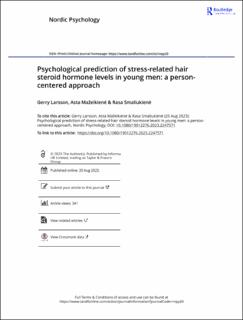| dc.contributor.author | Larsson, Ulf Gerry | |
| dc.contributor.author | Mažeikienė, Asta | |
| dc.contributor.author | Smaliukienė, Rasa | |
| dc.date.accessioned | 2024-02-14T11:31:32Z | |
| dc.date.available | 2024-02-14T11:31:32Z | |
| dc.date.created | 2023-09-05T09:35:07Z | |
| dc.date.issued | 2023 | |
| dc.identifier.citation | Nordic Psychology. 2023, . | en_US |
| dc.identifier.issn | 1901-2276 | |
| dc.identifier.uri | https://hdl.handle.net/11250/3117487 | |
| dc.description.abstract | The aim was to: (1) identify individual profiles in young men regarding personality and cognitive appraisal style employing easy-to-use instruments, and (2) to explore how such profiles relate to biological stress indicators. The sample consisted of 173 male Lithuanian conscripts. An assessment was made after one month into their basic military training. Levels of cortisol, cortisone and testosterone were established through analysis of hair samples. Psychological assessments included the Big Five model of personality as well as cognitive appraisal style and perceived stress during the previous month of service. Four unique personality profiles were identified in a cluster analysis that differed significantly as theoretically expected on the Perceived Stress Scale. Statistically significant between-profile differences were found on cortisol and cortisone but not on testosterone. The personality profile with the highest scores on all three biological markers was characterized by high scores on Extraversion and Openness and low scores on Agreeableness. Second, three distinct cognitive appraisal style profiles emerged. They were related as theoretically expected to perceived stress, but they were unrelated to the hair steroid hormone concentration levels. Third, the combination of the most psychologically vulnerable personality profile, which included low scores on Emotional stability, and the most stressed cognitive appraisal style profile, yielded the clearest result and showed that it was possible to detect individuals with significantly higher stress-related hair steroid hormone levels using psychological instruments. Practical potential implications include identification of individuals who are most psychologically vulnerable and in need of close monitoring. | |
| dc.language.iso | eng | en_US |
| dc.rights | Navngivelse 4.0 Internasjonal | * |
| dc.rights.uri | http://creativecommons.org/licenses/by/4.0/deed.no | * |
| dc.title | Psychological prediction of stress-related hair steroid hormone levels in young men: a person-centered approach | en_US |
| dc.title.alternative | Psychological prediction of stress-related hair steroid hormone levels in young men: a person-centered approach | en_US |
| dc.type | Peer reviewed | en_US |
| dc.type | Journal article | en_US |
| dc.description.version | publishedVersion | |
| dc.source.pagenumber | 13 | en_US |
| dc.source.journal | Nordic Psychology | en_US |
| dc.identifier.doi | 10.1080/19012276.2023.2247571 | |
| dc.identifier.cristin | 2172354 | |
| cristin.ispublished | true | |
| cristin.fulltext | original | |
| cristin.qualitycode | 1 | |

